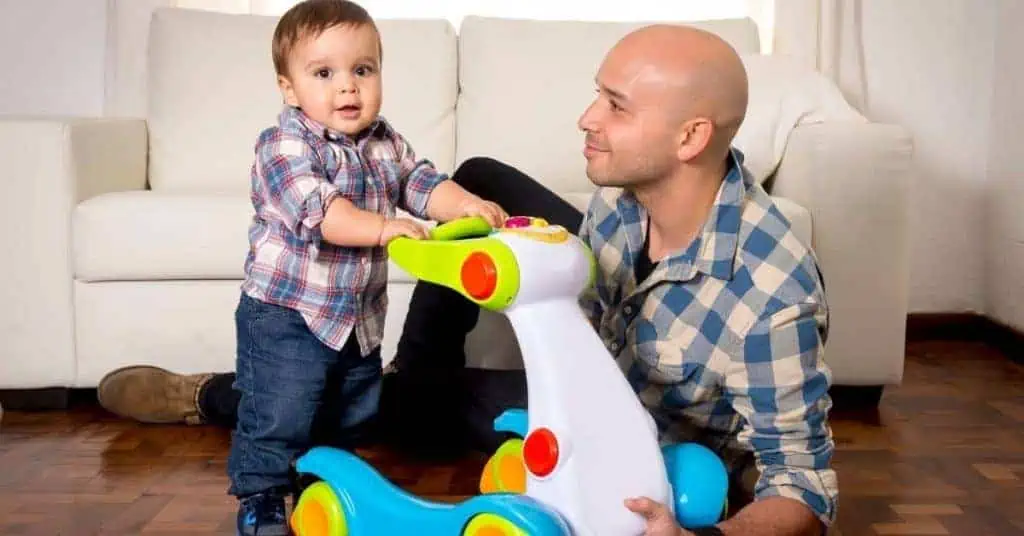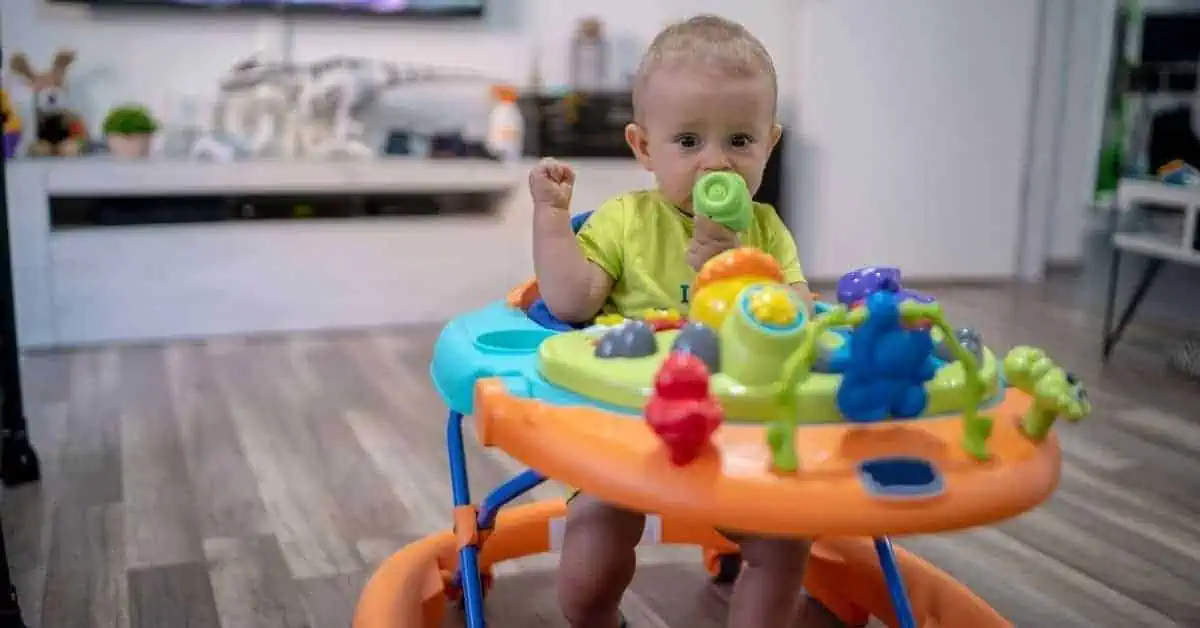WHAT AGE CAN A BABY GO IN A WALKER?
This post may contain affiliate links. As an Amazon Associate, I earn from qualifying purchases.
This week, Amy Vincent from Amy Baby Review shares her insight on a controversial topic: baby walkers!
You want to help your little one make his first footstep. That’s why planning to bring home a baby walker. But before doing so, you want to be sure what age can a baby go in a walker? If yes, this guide is for you. You’ll find a complete answer here. So, continue reading!
[convertkit form=1551829]
At what age should a baby be put in a walker?
Baby walkers are available for children between the ages of 4 to 16 months. But there is no appropriate age for babies to go in a walker because every child’s developmental milestone is different.
When your baby can touch the floor with his feet and able to hold his own weight for a while and hold his head up quite steadily, at that time, you can assume the little one can start using a walker.
But don’t forget giving a walker to your baby is like giving a license to drive an F1 racing car around the house. That’s why whenever the child plays with this kind of toy, your observation is mandatory to avoid injury.
Related read: How Can I Help My Baby Sleep?
Are baby walkers safe for development?
Experts from all over the world have different opinions about the use of baby walkers. But there is absolutely nothing wrong with putting a baby in a walker if you take all safety precautions properly, like blocking stairways, kitchen ways, etc. Most babies get injured reaching these unsafe areas using a walker.
You should also limit the time in using a baby walker. The little one should not stay in the walker for more than 30 minutes a day.
It’s because the baby should spend most of the time on the floor in the open. He’ll sit up, roll over, crawl, and pull himself up. Those are the natural developmental milestones.
It’ll build up his core muscles and learn to walk. If you put the baby in the walker for hours, it may hamper the natural development and delay in walking.
If you want to read more useful guides about baby walkers, you can visit Amy A. Vincent’s blog as she has published lots of valuable articles there!
Related read: Baby Clothes Organization Ideas

What are the pros and cons of a baby walker?
Everything has a good and a bad side. And a baby walker is not different. Let’s discuss the advantages and disadvantages of a baby walker:
Baby walker pros:
– Baby walkers keep your little one engaged all the time. Most of the walkers come with different toys on the play panel to keep the child busy and engaged.
– The colorful toys and shape sorters develop motor skills and stimulate the cognitive process of your child.
– It works as a great walking aid and helps your baby learn the critical skill of walking.
– You get more time to do your household task like cooking, cleaning, etc.
– When the baby uses a walker, you don’t have to hover behind him. It helps your child move independently.
Baby walker cons:
– Though we give baby walkers to our child for learning to walk, studies have shown — children who used walkers delayed in walking compared to children who didn’t use them. However, the delay is mostly one month long.
– Baby walkers allow children to move with independence. They might reach dangerous objects like knives, cooktops, or unsafe areas like bathrooms or swimming pools.
– The natural process of learning to walk is, when a baby tries to walk, he’ll fall, then again, he’ll make another attempt. By doing so, he’ll gain confidence and learn to walk.
But some parents are too afraid to let their babies walk on their own.
That’s why they bring home a baby walker. But falling down during learning to walk is completely normal, and it is also a part of the little one’s development.
– Sometimes, the walker might tip over, and the baby might get hurt. Besides, some walkers have sharp edges that might wound the little legs.
Related read: 6 Toddler Home Activities
Different types of baby walkers:
There are a few basic types of baby walkers available in the market which I’ve described below:
Convertible walker:
The convertible walker comes with a 2 in 1 feature that allows you to flip it from a seated walker into a sit-to-stand one. Firstly, you can put the baby in the walker to learn to walk.
When the little one starts wobbling or becomes a master of walking, you can convert it to a sit-to-stand walker. So, the baby can push it around the house with his favorite toys.
Seated walker:
A seated walker is known as the traditional walker. It allows the baby to sit in it. There are leg holes cut out so the little legs can touch the floor. Usually, babies who can sit up and hold their heads on their own are suitable for this walker.
Most of the seated walkers come with a removable play panel. So, the included toys and music keep the baby engaged and develop cognitive skills.
Sit-to-stand walker:
A sit-to-stand walker is also known as a push walker. It helps children gain stability and become the master of walking. The little one uses it as a shopping cart.
Most push walkers come with a removable play panel that includes different shape sorters, colorful toys, music, etc.
When there is enough pushing around the house, the little one can sit on the floor, play with the toys on the panel, and listen to music.
Some sit-to-stand walkers have a storage center that allows children to travel with their favorite toys and store them all together.
Related read: 10 Must Have Baby Products for the First Year
Which baby walker will be good for my baby?
I always prefer and recommend a convertible walker. The reason is it allows you to use it in two ways. So, you get more out of your purchase and also get peace of mind.
On top of this, it saves your money as you don’t need to buy a new one when the baby learns to walk —just simply convert from the seated walker to a sit-to-stand unit.
If you want to get the best baby walker for your little one, you need to look for some key features. You can check them out by following the link!
The wrap-up:
Thanks for reading the complete guide about the baby walker. I hope you’ve found this article helpful. To sum up, I want to mention again that a baby walker is entirely safe if you use it for a limited time.
But before allowing your little ones to play with a walker, you should use safety gates on stairways, kitchen, bathroom, and other unsafe places. And never leave your child alone with a walker to avoid accidents.







